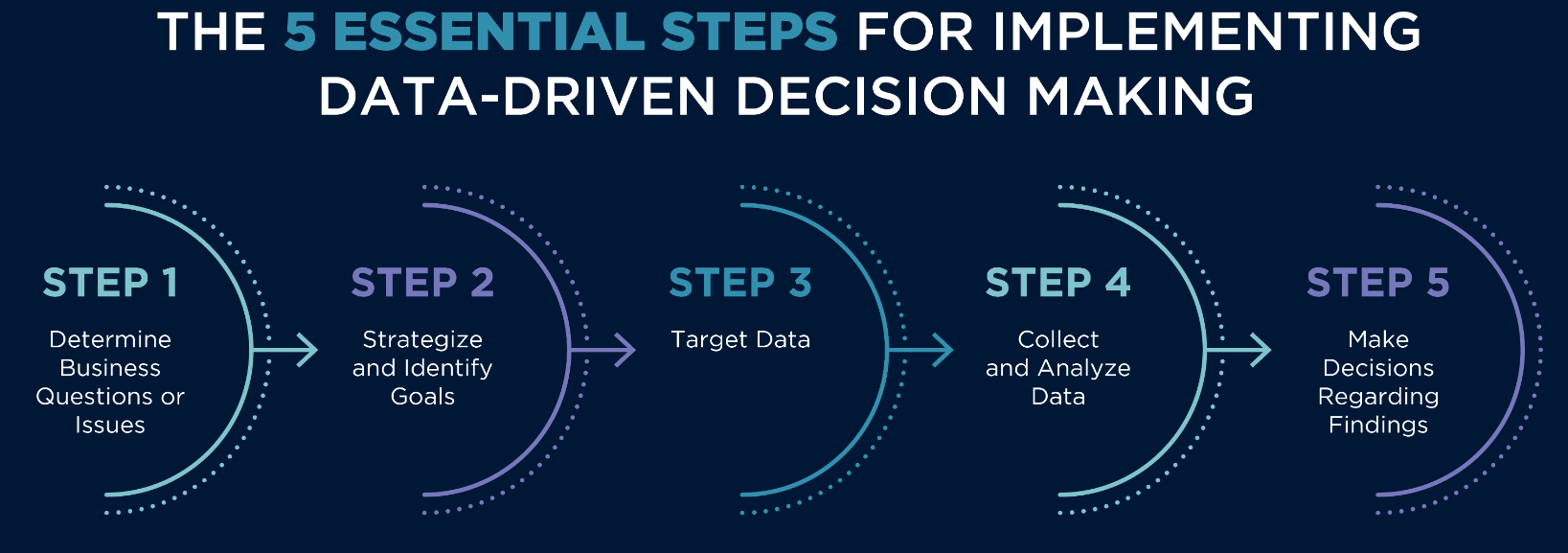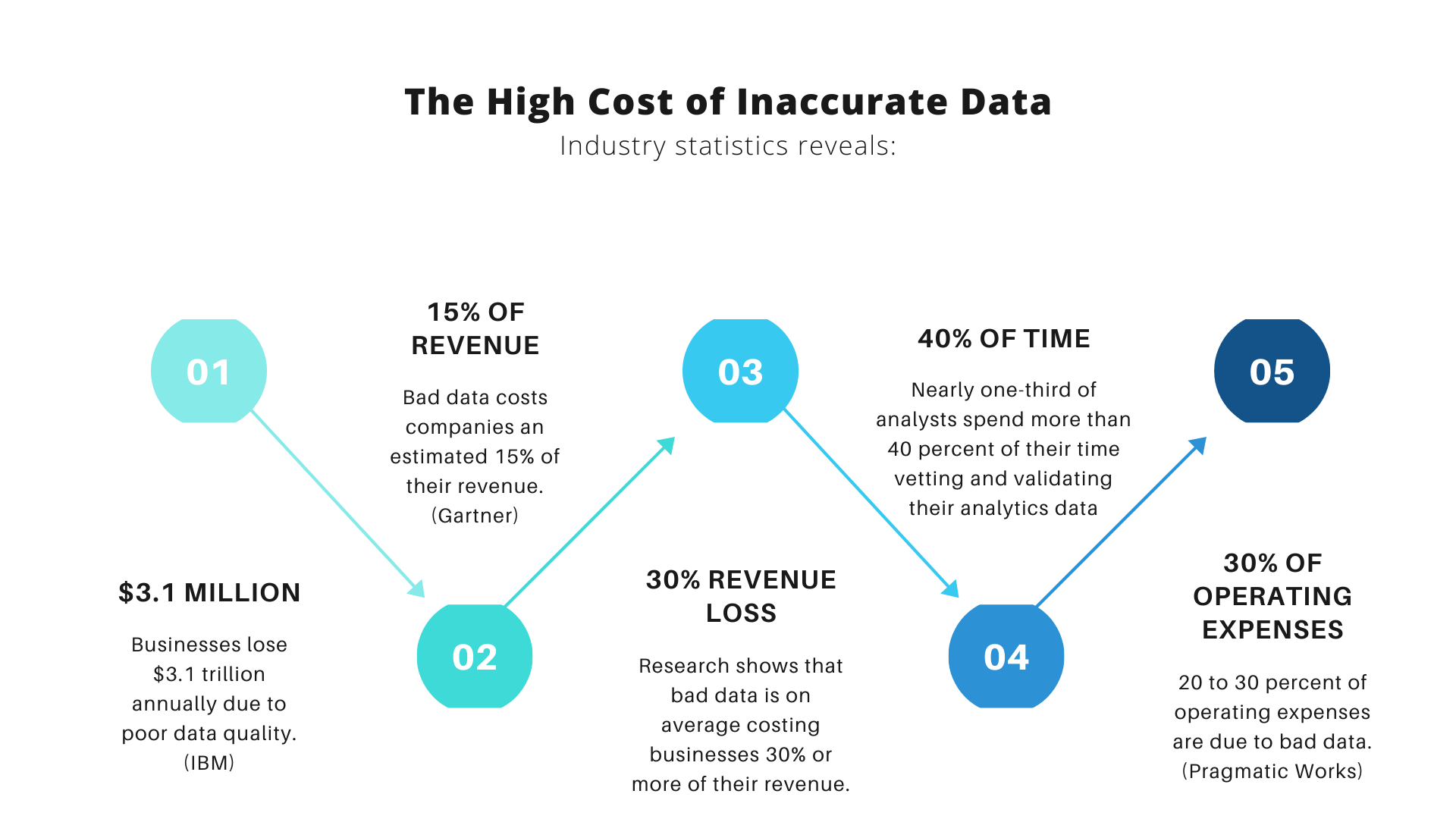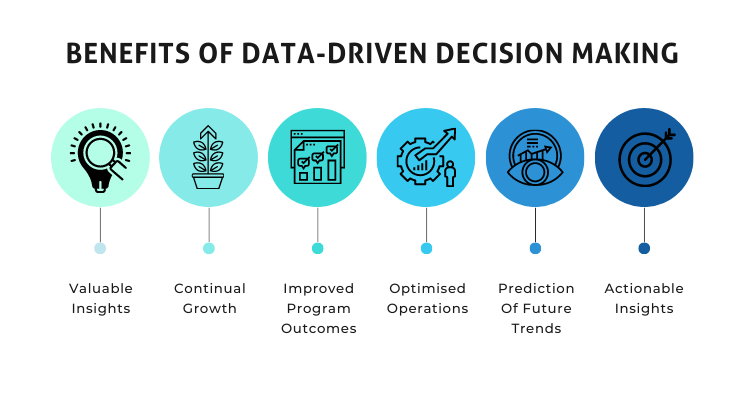
Going with your gut instinct may make you feel more in control of your decisions, but will those decisions be the best ones for your team members? You might feel more at rest knowing that the decisions you make are supported by facts and intended to have the greatest possible commercial impact. Using facts, measurements, and data to inform strategic business decisions that are in line with your goals, objectives, and initiatives is known as data-driven decision-making (DDDM).
Everyone—whether you're a business analyst, sales manager, or human resource specialist—is empowered to make better decisions with data every day when firms grasp the full potential of their data. The next strategic opportunity cannot simply be found by selecting the right analytics technology, though.
Your company has to establish data-driven decision-making as the standard, fostering an environment that values skepticism and curiosity. Data is the starting point of interactions at every level, and people improve their data abilities via practice and application. Data-driven decision making is an essential component of corporate strategy in the current world, whether it's for dominating competitors or boosting profitability. In the sections below, we explore the advantages of data-driven decision making and offer advice for using it in the workplace.
What is Data-Driven Decision Making?
Data-driven decision making is an approach to decision making that involves using data and analysis to inform and guide decisions. Rather than relying on intuition or guesswork, data-driven decision making involves collecting and analyzing data to identify patterns, trends, and insights that can inform decisions. This approach can be used in a variety of industries and functions, including marketing, finance, operations, and more. By using data to guide decision making, businesses can make more informed and objective decisions, leading to better outcomes and a competitive edge in their industries.
Data-driven decision making is particularly useful today for several reasons:
Availability of Data: Today, data is more readily available than ever before. With the growth of digital technologies, businesses can collect vast amounts of data on everything from customer behavior to product performance. Data-driven decision making allows businesses to leverage this data to make more informed decisions.
Increased Complexity: With the increasing complexity of business operations, it can be difficult for decision makers to rely solely on intuition or experience. Data-driven decision making provides a more objective and analytical approach, allowing decision makers to better understand the complexities of their businesses.
Rapidly Changing Markets: Today's markets are more dynamic and fast-paced than ever before. By using data to guide decision making, businesses can quickly adapt to changing market conditions, identify new opportunities, and respond to emerging trends.
Growing Competition: With increased global competition, businesses need to be more agile and responsive than ever before. Data-driven decision making provides a competitive advantage by enabling businesses to make faster and more informed decisions.
Improved Technology: Advances in technology, including machine learning and artificial intelligence, are making it easier and more efficient to collect, analyze, and interpret data. This is enabling businesses of all sizes to adopt data-driven decision making and gain a competitive edge in their industries.

Components of DDMM
Before we go into the details of data-driven decision making, it's important to understand the elements that you need before you can go ahead and start making decisions. There are at least two key components to successful data-driven decision making and without these components, you can't successfully create a data-driven culture.
1) Data must be accurate and relevant.
First and foremost, you need to make sure that your data is correct and pertinent to the outcomes you want from your goals. Making decisions based on erroneous data can have a significant impact on your company's performance, and examining data that isn't pertinent to your objectives further compounds the potential inefficiencies that you and your company may be dealing with.
There are a few tips you can take to ensure accurate data within your organization:
- Gather data from accurate resources
- Delegate workload across teams
- Regulate data accessibility
- Review and clean data

2) Data is thought-provoking.
The Role of DDMM for Businesses
Data may help you make more educated decisions, demonstrate progress toward company goals, better understand your customers, and increase operational effectiveness. These four advantages of data-driven decision-making may encourage you to participate in the data revolution.
Consistency in decisions: Having a data-driven organization has the advantage of ensuring consistency throughout time. The method makes it easier for organization members to understand how decisions are made. Stakeholders and customers are able to recognize the effects of data that is being gathered, examined, and controlled, and they respond accordingly. Every person gains the necessary abilities when they participate in data-driven decision management, which increases consistency. Businesses that rely on this practice can determine whether sales are up or down, whether customers are satisfied or not, and what strategies are effective for the business and other divisions. As a result of raising awareness, the organization is better able to foster responsibility, involvement, and loyalty.
Reduce Costs: Another attainable objective is to use your data to bring costs down as well as revenue. The ability to see your business from a broad perspective will enable you to make more informed decisions. For example, Nike has two different warehouses in Florida and Virginia. The corporation can use analyzed data to predict customer inventory needs in both locations which can aid in cutting costs for returns and logistics.
Increase Accountability: With real-time data access, have all the information in your fingertips. Who are your best performers? Which teams are lagging behind goals? Data-driven decision making increases accountability. When everyone has access to human resources data, leaders at every level can find out which teams are doing well and which ones need guidance so they can make changes before problems become critical.
Enhance Customer Experience: Enhancing customer experience is a crucial way that data can benefit your company. One illustration is the use of data to offer clients pertinent product recommendations. For instance, Amazon creates suggestions based on a user's personal search and purchase history as well as the histories of other customers who have similar tastes. Consumers who are going to make a purchase will see recommendations for related goods they might wish to buy right away as well as future suggestions. Consumers receive helpful advice, and business sales increase. The use of data allows the organizations to improve the customer experience this way.

Examples of Data-Driven Companies
1) Netflix
Netflix continuously gathers, examines, and depends on data input to advance its strategy and enhance customer happiness with new programs, appropriate ideas, and improved customer management. Their success in the market is a result of its industry-leading insights about what attracts customers the most, keeps them there longer, and where to focus future efforts on service improvement. Additionally, Netflix is able to give its users better suggestions and increase their satisfaction even further by analyzing historical search and viewing data.
2) Uber
Uber keeps records of every trip taken, whether or not passengers are present. In order to create predictions and continuously enhance the services, the organization also studies how transportation functions in other cities and nations. Uber addresses the most frequent problems for its clients and takes action to fix them using data analytics. The corporation also employs this technique to modify its demand and supply strategies, expand its market influence, and outperform rivals.
How Automation Guides Decision Making
Automation can guide decision making by providing timely, accurate, and relevant information that can be used to inform decisions. By automating data collection, analysis, and reporting, businesses can gain insights that they might not have otherwise discovered. Here are some ways that automation can guide decision making:
Real-time data collection: Automation can enable businesses to collect data in real-time, allowing them to quickly identify trends and patterns that might not be immediately apparent. This can help businesses make more informed decisions based on up-to-date information.
Automated analysis: By automating data analysis, businesses can save time and reduce the risk of errors. This can help businesses identify insights and patterns in their data that might have been missed through manual analysis. Automated analysis can also help businesses identify outliers or anomalies that could be indicative of larger trends or issues.
Predictive analytics: Automation can be used to create predictive models that can help guide decision making or maybe even determine why your projects are failing. By analyzing historical data and using machine learning algorithms, businesses can create models that can be used to predict future outcomes or identify potential risks.
Automated reporting: By automating reporting, businesses can quickly generate reports that provide insights and recommendations for decision making. These reports can be customized to include the most relevant information for each stakeholder, making it easier for decision makers to access the information they need.

